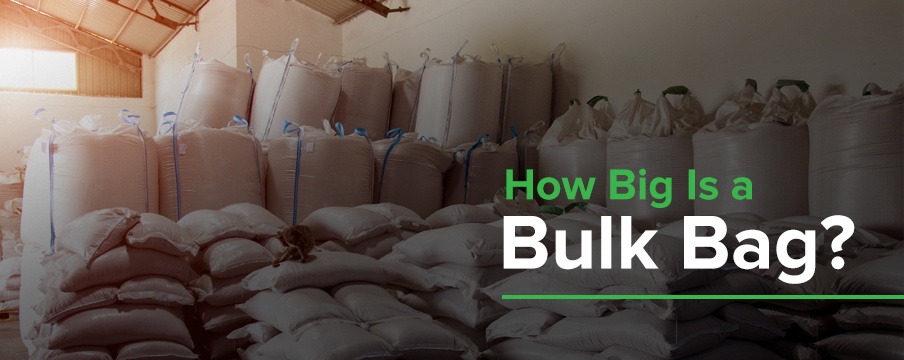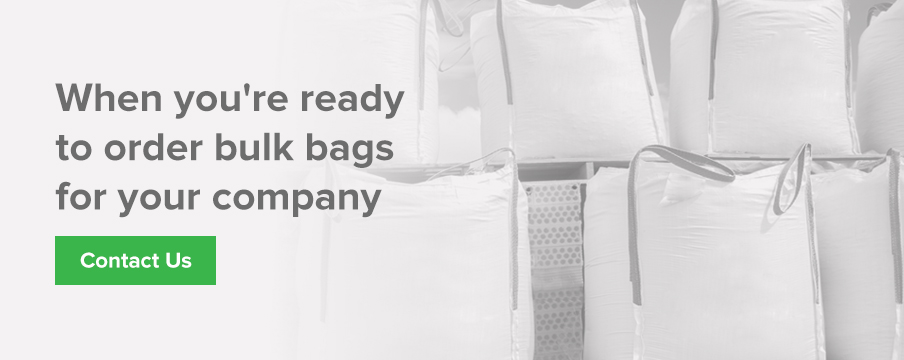How Big is a Bulk Bag?
If your company handles dry, flowable goods, like feed, fertilizer or sand, you probably already know that you need bulk bags to store and transport your products. But knowing what type and size of bulk bags to order can seem daunting. With so many choices, it can be hard to know where to start and what will be best for your business. Here’s everything you need to know about bulk bag dimensions and how to determine what size you need for your products.
What Sizes Do Bulk Bags Come In?
Also known as big bags, super bags, jumbo bags and flexible intermediate bulk containers (FIBCs), bulk bags have been used for many years. Bulk bags come in a variety of sizes, perfect for all sorts of industries. These super-strong industrial containers are constructed from flexible fabric and are ideal for the storage and transport of flowable, dry goods — everything from sand, gravel and building materials to feed, fertilizer, plastic granules and much more.
While bulk bags can come in many different sizes and shapes, most commonly, they are about 35 to 80 inches in height, and 35-48 inches in width. These measurements can often be customized for different industries and purposes. The bags themselves weigh about 5 to 7 pounds, but can often hold upwards of 1,000 to 4,000 pounds of materials.
It can be challenging to picture just how big this is, with just the measurements, and know which sizes to order for your company. Usually, bulk bags are stored on pallets, which themselves are several inches high. A bulk bag on a pallet will generally stand at about hip or waist high when full, with an average-height person standing next to it. The bags may have handles that stand up a bit higher.
If you’ve never used bulk bags before, you may be surprised by just how large they actually are. These containers are quite large and take up a lot of space!
How Size Affects Weight and Pallet
Bulk bags are generally much larger than other storage containers, such as cardboard boxes. So, it’s important to take into account how the larger size of these containers can affect their overall weight and how they need to be stored.
Because the bulk bags can hold up to two tons (4,000 pounds) of product, they often require special equipment to lift and move them. The bags should usually be stored on pallets to keep the product off of the floor and make moving them easier.
Depending on what types of products and materials are being stored in the bulk bags, you’ll need to consider the pallets you use and if they are strong enough to hold the added weight of bulk bags. A standard-sized pallet will hold a 35-inch square bulk bag. However, once you fill the bag with product, depending on the materials, it may sag over the sides of the pallet, affecting your ability to easily and safely store and move the bag and pallet. The bags are rectangular at the bottom when empty, but as they are filled, they generally take on a more cylindrical shape.
It may be necessary to use larger pallets than the standard size and ones that have the proper slat arrangement to safely support the weight and shape of the full bulk bag. If storage space is a concern, it’s essential to keep in mind the size and shape the bulk bag will take on when full and to make sure to have the proper pallets to support your bulk bags. Using the right pallets for your bulk bags means that your product will be stored safely and securely and can be moved more efficiently.
Which Size of Bulk Bag Is Best for My Industry?
Bulk bags can be used for all sorts of industries and come in a variety of shapes and sizes, with different features ideal for distinct industrial purposes. The right bulk bag for your business depends on the industry you are in and what you use the bulk bags for. One of the most important considerations when choosing bulk bags is the size of the bags.
A good place to start is to determine the size and weight of the product you’ll be storing in the bulk bags. This goes beyond a simple width by height measurement of the stored product. The two most important considerations for determining size are:
- Product weight: Start with the bulk weight of your product per cubic foot. Determine the amount of product you wish to store or transport per bag and divide this number by the bulk weight per cubic foot. This amount will tell you the ideal capacity for each bulk bag you need.
- Pallet size: Also, consider the size of the pallets you will use for your bulk bags. The pallets should be the correct size for the footprint of the bag. Make sure that your bulk bags and pallets are a good match for the size and weight of your product.
When determining what type and size of bulk bag you need, it’s a good idea to consider the other features of the bag too. Most bulk bags have handles or loops on top, so consider the height and placement of the handles. Bulk bags are also available with several different tops — open top, duffle top and spout top. The type of product you are storing, as well as the method for pouring, will determine the type of bag that you need. Just remember to take into account the top of the bags when determining the total size and how they will be stored.
Contact Bulk Bag Reclamation
When you’re ready to order bulk bags for your company, contact Bulk Bag Reclamation. We are happy to assist you in selecting the right bulk bags for your needs. Bulk Bag Reclamation has a wide variety of types and sizes of bags to choose from, and all bags are carefully reconditioned — so you’ll not only save money on bulk bags, your company can be a little more eco-friendly too! Our bags go through rigorous cleaning and inspection standards to ensure that you receive the highest quality reconditioned bulk bags. We can even recondition your existing stock of bulk bags. Keep bulk bags out of the landfill by choosing reconditioned bags from Bulk Bag Reclamation. Get started by requesting a quote today.



